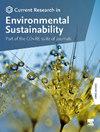什么有效,在哪里有效,如何有效?印度气候变化适应措施的系统文献综述
IF 3.8
Q2 ENVIRONMENTAL SCIENCES
Current Research in Environmental Sustainability
Pub Date : 2025-01-01
DOI:10.1016/j.crsust.2025.100291
引用次数: 0
摘要
复杂的社会政治环境和不断增加的生物物理压力加剧了印度对气候变化的脆弱性。为应对这些挑战,各国正在制定若干政策和开展实地工作,以推进气候变化适应。然而,找出什么有效、在哪里有效以及如何有效,对印度CCA的进展至关重要。为了评估当前的适应实践和措施,我们旨在回顾现有的适应研究,为印度的适应措施提供有价值的见解。在本文中,我们对印度的适应措施进行了系统的文献综述。我们绘制了分析CCA的英语科学期刊文章(n = 2124),特别强调了2017年至2023年印度的渐进式和变革性适应。我们发现,只有(n = 28%)的文章明确地关注了适应措施,其余的文章则粗略地提到了适应措施在减少气候变化影响方面的重要性。然而,论文发表数量稳步增长,在2021年达到顶峰(n = 10)。在2019冠状病毒病大流行之后,各学科的适应相关文章激增。此外,只有有限数量的文章关注CCA措施,缺乏关于如何理解和解释文献中增量和变革措施的清晰度。这些文献主要集中在围绕农业部门的技术官僚方法,如作物多样化、改变种植和栽培周期、使用杂交种子、土壤保持实践和生计多样化。此外,地理上的不平衡是明显的,在印度东北部等脆弱地区的适应研究有限。我们得出的结论是,尽管气候变化对印度的影响是巨大的,但在CCA措施的学术文献中存在明显的知识差距,包括与妇女有关的性别问题、软适应措施(如能力建设和教育)以及敏感山区系统的脆弱性。鉴于这些差距,未来的研究应解决适应文献中的地理和主题失衡问题,强调弱势社区、性别动态和城市复原力。本文章由计算机程序翻译,如有差异,请以英文原文为准。
What works, where and how? A systematic literature review of climate change adaptation measures in India
The complex socio-political landscape and increasing biophysical pressures exacerbate India's vulnerability to changing climate. In response to these challenges, several policy and on-the-ground efforts are being made towards advancing climate change adaptation (CCA). However, finding out what works, where and how is critical to the progress of CCA in India. To take stock of current adaptation practices and measures, we aim to review the existing adaptation research, providing valuable insights into India's adaptation measures. In this article, we present a systematic literature review that analyses the adaptation measures in India. We mapped English-language scientific journal articles that analysed CCA (n = 2124), particularly emphasising incremental and transformative adaptation in India between 2017 and 2023. We found that only (n = 28) per cent of articles focused categorically on adaptation measures, and the rest cursorily mentioned its importance in reducing the impacts of climate change. However, the number of publications steadily increased, peaking in 2021 (n = 10). Following the COVID-19 pandemic, a surge of adaptation-related articles was observed across various disciplines. Moreover, with only a limited number of articles focusing on CCA measures, there is a lack of clarity on how incremental and transformative measures are understood and explained in the literature. The literature focused mainly on technocratic approaches around agriculture sectors such as crop diversification, changing cropping and cultivation cycles, use of hybrid seeds, soil conservation practices, and livelihood diversification. Additionally, a geographical imbalance is evident, with limited research on adaptation in vulnerable regions such as northeast India. We conclude that while the impact of climate change on India is substantial, there are apparent knowledge gaps within the academic literature on CCA measures, including gender issues concerning women, soft adaptation measures such as capacity building and education and vulnerability of sensitive mountain systems. Given these gaps, future research should address the geographical and thematic imbalances in adaptation literature, emphasising vulnerable communities, gender dynamics and urban resilience.
求助全文
通过发布文献求助,成功后即可免费获取论文全文。
去求助
来源期刊

Current Research in Environmental Sustainability
Environmental Science-General Environmental Science
CiteScore
7.50
自引率
9.10%
发文量
76
审稿时长
95 days
 求助内容:
求助内容: 应助结果提醒方式:
应助结果提醒方式:


